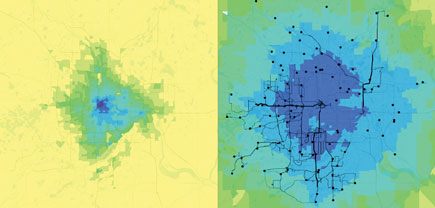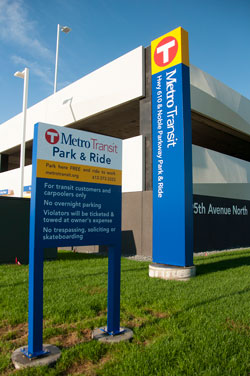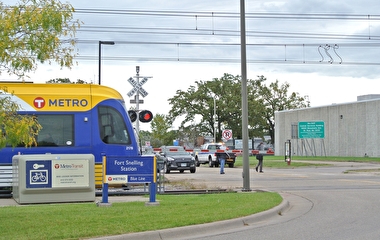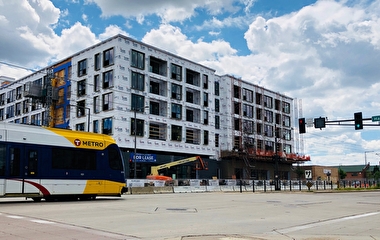and routes that use managed lanes (right) as a percentage of auto
accessibility at 60 minutes of travel. Darker colors show higher levels
of competitiveness with auto.
Researchers at the U of M’s Accessibility Observatory have developed new methods for assessing accessibility to jobs by transit in the Twin Cities metro area.
The multi-stage study, sponsored by the Minnesota Department of Transportation (MnDOT) and supervised by Observatory director Andrew Owen, focused on accounting for the effects of managed lanes and park-and-ride (PNR) facilities in transit accessibility measures.
“By incorporating new elements of the transportation network into our calculations, we improve our ability to track accessibility changes across a region,” says Observatory researcher Kristin Carlson, the lead researcher on the project. “This ultimately expands the role accessibility can play as an assessment tool for planners and engineers.”
As part of the project, the researchers were especially interested in exploring the potential of managed lanes and PNR facilities to boost the competitiveness of the transit network compared to auto accessibility at similar time thresholds.
To begin their analysis, the researchers designed a new methodology to calculate how the MnPASS managed lane network contributes to accessibility. This work included developing and implementing a special computer program to edit transit schedule datasets for the 60 express buses that run at least partially on the existing managed lane network in the Twin Cities. The modified data were then used to evaluate the system-wide accessibility impacts of managed lanes.
Findings indicate that, at the regional scale, managed lanes result in only modest accessibility gains. However, at the local level, the impacts are much larger. The average worker living within a half-mile of a transit stop on a route that uses a managed lane can experience a nearly 13 percent increase in accessibility to jobs within 30 minutes.
Next, the team developed a mixed-mode methodology to examine the effects on accessibility of the 114 PNR locations across the Twin Cities. This involved creating a blend of auto and “walk-up” transit accessibility profiles to account for the driving and transit components of each PNR trip.
“By incorporating access to transit service via automobile, we found that suburban and exurban areas have higher levels of transit accessibility where they had previously been considered low,” Carlson says. “Overall, PNR accessibility is three times greater than walk-up transit accessibility for the average Twin Cities worker.”
When taken together, managed lanes and PNRs increase transit’s competitiveness with auto by 19.1 percent at the 60-minute travel time threshold. The largest gains are in first- and second-ring suburbs located near the MnPASS lanes operating on I-35W, I-35E, and I-394. These accessibility benefits are strengthened in areas with active PNR facilities, such as I-35W at Highway 36 and I-94 at I-694.
Going forward, the researchers plan to apply what they’ve learned on this project to additional work. The computer program created to analyze the effects of managed lanes, for example, has already been used for accessibility analyses related to the Rethinking I-94 project.
In addition, Carlson says the methodology developed to analyze the contributions of PNR facilities could serve as a launch point for future evaluations of accessibility related to shared mobility, since it allows for mixed-mode trip analysis.
“The growing prevalence of transportation network companies and their potential to help or hinder transit ridership makes this area especially fitting for further study,” Carlson says.




